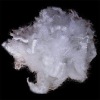KEXU textile produce para-aramid yarn from 2008. Now it's one of biggest para-aramid yarn spinners in China. We produce para-aramid yarn from 40S to 7S. We have good reputation in Cut resistant PPE knitting and sewing of PPE for good/stable quality and on-time-delivery.
Kevlar is famous because its high strength-to-weight ratiofamously: "...5 times stronger than steel on an equal weight basis..."
When Kevlar is spun, the resulting fiber has great tensile strength (ca. 3 620 MPa), and a relative density of 1.44. When used as a woven material, it is
suitable for mooring lines and other underwater applications.
Properties:
There are three grades of Kevlar: (i) Kevlar, (ii) Kevlar 29, and (iii) Kevlar 49. Typically, Kevlar is used as reinforcement in tires and rubber mechanical
goods. Kevlar 29's industrial applications are as cables, in asbestos replacement, brake linings, and body armor. Kevlar 49 has the greatest tensile strength
of all the aramids, and is used in plastic reinforcement for boat hulls, airplanes, and bicycles. The ultraviolet light component of sunlight degrades and
decomposes Kevlar, a problem known as UV degradation, and so it is rarely used outdoors without protection against sunlight.
Fibers of Kevlar consist of long molecular chains produced from PPTA (poly-paraphenylene terephthalamide). There are many inter-chain bonds making the
material extremely strong. Kevlar derives part of its high strength from inter-molecular hydrogen bonds formed between the carbonyl groups and protons on
neighboring polymer chains and the partial pi stacking of the benzenoid aromatic stacking interactions between stacked strands. These interactions have a
greater influence on Kevlar than the van der Waals interactions and chain length that typically influence the properties of other synthetic polymers and
fibers such as Dyneema. The presence of salts and certain other impurities, especially calcium, could interfere with the strand interactions and caution is
used to avoid inclusion in its production. Kevlar's structure consists of relatively rigid molecules which tend to form mostly planar sheet-like structures
rather like silk protein.
APPLICATIONS:
Armor
Kevlar is well-known as a component of some bullet resistant vests and bullet resistant face masks. The PASGT helmet and vest used by United States military
forces since the early 1980s both have Kevlar as a key component, as do their replacements. Other military uses include bulletproof facemasks used by
sentries. Civilian applications include Kevlar reinforced clothing for motorcycle riders to protect against abrasion injuries and also Emergency Service's
protection gear if it involves high heat (e.g., tackling a fire), and Kevlar body armor such as vests for police officers, security, and SWAT.
Rope and cable
The fiber is used in woven rope and in cable, where the fibers are kept parallel within a polyethylene sleeve. Known as "Parafil", the cables have been used
in small suspension bridges such as the bridge at Aberfeldy in Scotland. They have also been used to stabilise cracking concrete cooling towers by
circumferential application followed by tensioning to close the cracks.
Sports equipment
Kevlar is very popular material for racing canoes (Adirondack Canoe Classic, Saranac Lake, NY)It is used as an inner lining for some bicycle tires to prevent
punctures, and due to its excellent heat resistance, is used for fire poi wicks. It is used for motorcycle safety clothing, especially in the areas featuring
padding such as shoulders and elbows. It was also used as speed control patches for certain Soap Shoes models. In Kyudo or Japanese archery, it may be used
as an alternative to more expensive hemp for bow strings. It is one of the main materials used for paraglider suspension lines.
Electricity generation
Kevlar was used by scientists at Georgia Institute of Technology as a base textile for an experiment in electricity-producing clothing. This was done by
weaving zinc oxide nanowires into the fabric. If successful, the new fabric would generate about 80 milliwatts per square meter.[5]
Drumheads
Kevlar is sometimes used as a material in high tension drum heads usually used on marching snare drums. It allows for an extremely high amount of tension,
resulting in a cleaner sound. There is usually some sort of resin poured onto the kevlar to make the head airtight, and a nylon top layer to provide a flat
striking surface. This is one of the primary types of marching snare drum heads. Remo's falam slam patch is made with kevlar and is used to reinforce bass
drum heads where the beater strikes.
Woodwind reeds
Kevlar is used in the woodwind reeds of Fibracell. The material of these reeds is a composite of aerospace materials designed to duplicate the way nature
constructs cane reed. Very stiff but sound absorbing Kevlar fibers are suspended in a lightweight resin formulation.
Fiber Optic Cable
Kevlar is widely used as a protective outer sheath for optical fiber cable, as its strength protects the cable from damage and kinking.
Building construction
A retractable roof of over 60,000 square feet (5,575 square metres) of Kevlar was a key part of the design of Montreal's Olympic stadium for the 1976 Summer
Olympics. It was spectacularly unsuccessful, as it was completed ten years late and replaced just ten years later in May 1998 after a series of problems.[6]
[7]
Brakes
The chopped fiber has been used as a replacement for asbestos in brake pads. Dust produced from asbestos brakes is toxic, while aramids are a benign
substitute.[citation needed]
Expansion joints and hoses
Kevlar can be found as a reinforcing layer in rubber bellows expansion joints and rubber hoses, for use in high temperature applications, and for its high
strength. It is also found as a braid layer used on the outside of hose assemblies, to add protection against sharp objects.












